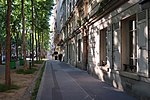École militaire
1750 establishments in FranceBuildings and structures in ParisBuildings and structures in the 7th arrondissement of ParisEducation in ParisEducational institutions established in 1750 ... and 3 more
Military academies of FrancePalaces and residences of NapoleonTerminating vistas in Paris

The École militaire (French: [ekɔl militɛːʁ]; "military school") is a complex of buildings in Paris, France, which house various military training facilities. It was founded in 1750 by King Louis XV and is located in the 7th arrondissement of Paris, southeast of the Champ de Mars. The building, constructed by Ange-Jacques Gabriel, is an active military academy and is classified as a national monument since 1990. This site can be visited during the European Heritage Days.
Excerpt from the Wikipedia article École militaire (License: CC BY-SA 3.0, Authors, Images).École militaire
Place de Fontenoy - UNESCO, Paris 7th Arrondissement (Paris)
Geographical coordinates (GPS) Address External links Nearby Places Show on map
Geographical coordinates (GPS)
| Latitude | Longitude |
|---|---|
| N 48.8525 ° | E 2.3036111111111 ° |
Address
École Militaire
Place de Fontenoy - UNESCO
75007 Paris, 7th Arrondissement (Paris)
Ile-de-France, France
Open on Google Maps









